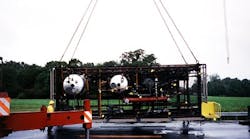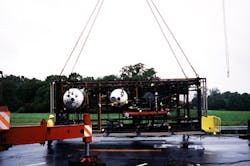Modular construction hasn't gained the role it deserves for pilot plants. Our experience at ExxonMobil Research and Engineering shows that building pilot plants in one central facility whenever possible for shipment and installation around the world makes a lot of sense.
The approach is based on building units in sections that readily can be transported by road, rail or sea depending on the final destination. Road transportation is most common and also most restrictive. Larger modules are possible but become significantly more costly and impose more limitations on routes available. Standard road-transportable sizes are more than adequate for most pilot plants and even small-scale demonstration units. You simply design the modules to be smaller or to come apart for shipment.
Modular construction isn't a new idea; the petrochemical industry has used it for decades. However, it's often just considered for avoiding onsite construction in inhospitable or inaccessible locations like the North Sea or in areas with inadequate infrastructure. In these cases, it may be the only practical option. However, the approach offers many benefits for projects that don't suffer from these obvious handicaps.
Compelling Advantages
Modular construction allows most pilot plants to be fabricated in a controlled environment, typically a shop specializing in modular or pilot-plant and laboratory unit construction. Shop construction always is more efficient than field construction because it can eliminate or at least minimize many inefficiencies and variables affecting productivity.
The work area usually is enclosed and protected from the weather. The room around the construction area generally is more open for access from all sides and is organized for greater efficiency. Section fabrication, layout and assembly often can take place on large worktables. Scaffolding or rolling platforms can surround larger components to reduce inefficient ladder use. Cranes and hoists -- permanent or temporary -- may be on hand to move and place larger equipment. Welding equipment or outlets are readily available.
Temporary construction power is easier to provide and usually already conveniently distributed around the work area. Specialty tools can be justified due to repeated use and result in significant cost savings. Stock rooms, equipment bins and similar materials storage can be set up nearby in a convenient location.
Operating restrictions such as permits, black-out times and access limitations are eliminated -- and with them, the time spent obtaining permits and clearances, accommodating operational needs, keeping traffic corridors open, relocating tools or equipment as operations require and a host of similar issues.
Shop construction also promotes a steady crew size. Field construction often involves obtaining new craft workers, training them in procedures and practices, and then releasing them at project end, losing all accrued orientation and experience. Shop construction frequently can be scheduled to keep the crews for longer periods -- thereby eliminating repeated training and learning curves.
The approach also increases quality because the shop conditions promote better work. Climate control ensures components aren't assembled in high humidity or bad weather that may result in internal corrosion, water or dirt damage. The proximity of specialty equipment allows better quality construction. Inspections usually are easier and more routine.
Our experience indicates that shop fabrication is 20%–50% more efficient than similar field construction. This is particularly true when onsite work would involve cramped spaces, such as laboratory hoods, or exterior locations exposed to weather.
Safety also benefits from the more organized and efficient approach to construction. It helps eliminate potentially unsafe field expedients and shortcuts. The more-open access typical of shop construction reduces ergonomic-related injuries because bending, stretching and contorted positions can be avoided through proper unit placement in the shop. The lack of hazardous materials decreases potential for worker exposure, fires, explosions or spills.
But Resistance Remains
Given these advantages why do companies still resist modular construction?
First there's a perception that units constructed offsite won't fit in their intended location. Horror stories abound, although upon investigation many appear to be more urban legends -- or at least classic cases of lack of adequate planning -- than truly relevant examples.
Modular construction does require more upfront design. You must determine how the unit can be moved into place, not just how to build it in place. This often creates problems because low beams, intruding piping or wiring, undersized doors and a host of similar problems arise. Yet, as anyone who's ever moved into a house knows, these issues almost always have viable solutions.
Modules can be made in sections and easily reassembled in place. You can temporarily remove or permanently enlarge doors. Walls often can be opened by detaching panels or even removing and replacing masonry. You can make modules to rig through roofs or upper walls. Existing site piping and wiring frequently -- with planning and advance notice -- can be economically rerouted or temporarily taken out and reinstalled. Such efforts can add to cost but usually are offset by savings modular construction can deliver.
Second, there's a sense a unit can't be economically and safely shipped long distance. Anyone who's ever seen major process units on highways will understand how even incredibly large items can be moved. Of course, as units get larger, routes available get more limited, preparations grow more involved, permits and escorts required more extensive and costs higher. However, most modules can be shipped with minimal problems at reasonable cost if they're properly designed to meet a few easy guidelines.
Most U.S. interstate highways are limited to a 15-ft. clearance. Low-boy air-ride trucks as low as 18 in. are available, thus affording a tight but realistic 13-ft. module height. Widths and lengths are more flexible but, in general, holding lengths to 20 ft. and widths to 10 ft. isn't a problem. Expansion to 40-ft. long and 15-ft. wide, while more costly, usually is an option. Recognize also that a module sometimes can be laid on its side for taller units (Figure 1) or stood up for wider units to meet these dimensions.
Modules must be structurally strong enough to endure lifting and transport. This doesn't mean, as some fear, they always must be enclosed with massive and expensive steel frames. In many cases, proper bracing or temporary supports add more-than-enough stiffness and strength. Other alternatives include crating for smaller modules or shipping skeletons that are applied over the module but removed upon installation (Figure 2).
While an added expense, these often can be reused or at least fabricated more crudely to reduce their cost. In many cases, standard strut pallets and frames can move across the continent with only minimal extra bracing if properly designed and constructed. Simple tricks like double nutting threaded rods, tack welding joints and clips can greatly increase vibration resistance.
Temporary packing measures, ranging from bracing, lashing, stuffing and wrapping to wooden or metal supports also can work incredibly effectively to reduce the risk of vibration damage. Removal of a minimal number of key components (such as glassware or high sensitivity instruments) also is a viable option if not carried to extremes. Air-ride trucks are readily available in almost any shape or size; these reduce the vibration on modules to realistically controllable limits.
Third, there's a nagging concern that what's fabricated offsite won't be what the organization wants or needs. This is a valid issue because many organizations, having decided to have something (large or small) constructed offsite, often basically abrogate all responsibility and rely on the fabricator's best judgment. When contracting anything offsite, the organization must convey all required information to the contractor. This includes a detailed design or design specification and also adequate information on in-house safety rules (both formal and informal) and equipment, operating and installation standards. Unfortunately, many installation practices and "standards" widely accepted at a given site are poorly if ever documented.
Some organizations seize on the effort necessary to provide such information as a reason for not considering modular construction. However, the savings possible almost always allow for this to be effectively addressed. And the effort leads to additional savings on the next project because it doesn't have to be repeated. Moreover, taking the time to collect and review these practices often generates additional savings from streamlined procedures, reducing unnecessary work or eliminating practices no longer required.
Guidelines For Effective Modular Construction
Carefully select the contractor. In addition to all the normal issues (technical skill, professionalism, quality, cost, etc.) the contractor must have adequate familiarity with the modular concept. Building a unit in a shop isn't hard but making sure it can be safely shipped and installed does require some significant training and experience.
Be willing to address problems that arise with an open mind. Spending some time and effort to reroute a line, widen a doorway, open a wall or accept a few days of scheduled downtime can go a long way toward reducing costs and improving the final product.
Learn from other's experience. Discuss problems and issues that have arisen with other users. Shamelessly question the contractor, the transportation company, the rigger and anyone else you can find about potential problems, past practices and horror and success stories and apply the results to your efforts.
Plan, plan and plan some more! No project ever suffered from too much advance planning. Modular projects, in particular, are very poor at trying to address issues in the field as opposed to upfront. Recognize that you may have to do a higher level of design, layout and review than you're normally accustomed to. You'll probably find, however, that this extra effort pays high rewards not just in the modular component but in the rest of the project as well.
An Under-Appreciated Option
Modular construction is a viable alternative for many pilot plants. Done properly it can reduce costs, alleviate onsite restrictions and produce a high-quality cost-effective unit.
Avoid Potential Problems
These 10 tips can help you forestall difficulties:
1. Select the contractor carefully. Make sure you have fully investigated its capabilities, experience and performance. Thoroughly check references.
2. Carefully plan the route the equipment will take into your facility. Look at alternative paths. Be open to relatively minor work such as rerouting lines, opening up doors or walls or temporarily relocating equipment that may allow larger modules to be brought in.
3. Recognize that larger units may come in several modules for easier shipment. Accept that some onsite erecting may save significant transportation costs and time.
4. Allocate adequate time for the extra planning and coordination modular construction requires.
5. Thoroughly review proposed piping and instrument drawings before committing to construction. Make sure fallback positions exist for new or novel approaches. Check that all process concerns are adequately addressed. Verify that interfaces with existing systems are fully dealt with.
6. Carefully evaluate the proposed skid layout for safety, ergonomic and process issues.
7. Ensure the design is fully and completely reviewed for safety. Confirm that detailed hazard analysis and risk assessment is conducted before the design is finalized. Check that the contractor understands all in-house safety rules, both formal and informal.
8. Make certain the design is comprehensively reviewed for process, operational and maintenance concerns and preferences. Use site-standard equipment suppliers and piping and wiring practices as much as possible.
9. Recognize the final product may look and seem different from units built in-house. If adequate reviews and planning have been conducted, this shouldn't be an issue but differences always make people feel uncomfortable. Make sure this is recognized and accepted in advance or the final product always will be suspect in some peoples' minds.
10. Obtain full and complete documentation from the contractor. At a minimum this should include electronic copies of all drawings and copies of all manuals, calculations and purchase orders..
Richard Palluzi is a senior engineering associate at ExxonMobil Research and Engineering Co., Annandale, N.J. E-mail him at [email protected].




